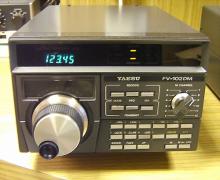I've been licensed as KA8KPN since 1980. I have sometimes told people that it was 1979, but that's my mistake. My true story about not having an ID for the general test, but having one for the amateur extra test implies that I was licensed the year I turned 16, which was 1980. That whole time, CW has been my mode. First, with a straight key, and then with a set of iambic paddles (I received a nice chrome based set of Bencher paddles for my 16th birthday.) The thing about iambic paddles is that you need a device called a keyer in order to actually use them for anything.

